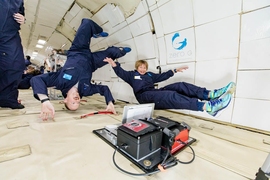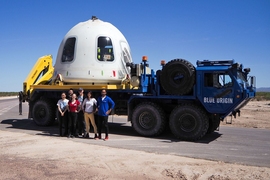Five research payloads from the MIT Media Lab’s Space Exploration Initiative were recently deployed on the International Space Station for a 30-day research mission. Scientists, designers, and artists will be able to study the effects of prolonged microgravity, on-station radiation, and launch loads on experiments ranging from self-assembling architecture to biological pigments. The payloads launched on the SpaceX CRS-20 via the Dragon cargo ship atop a Falcon 9 rocket on March 6.
This first launch to the ISS represents a key milestone in the schedule of iterative microgravity testing that the Space Exploration Initiative (SEI) undertakes throughout each year, following a successful Karman line launch with Blue Origin and a second parabolic research flight over the past 12 months.
“Sending five concurrent payloads to the International Space Station — this is a huge milestone for the team, and something we’ve been working towards explicitly for nearly a year,” says Ariel Ekblaw, SEI’s founder and lead.
The payloads were integrated into the Nanoracks BlackBox, a locker-sized platform with mechanical mounting points and electrical connections for power, data, and communication capabilities. Payloads are fully integrated into BlackBox on the ground; when they reach ISS, the astronauts aboard integrate them into ISS experiment racks, then simply leave them alone — the boxes are completely self-contained and remotely commanded via Nanoracks from the ground. This system allows for larger and more complex research payloads on the ISS, as the astronauts aren’t required to come near any potentially hazardous materials and don’t need any special expertise to run the experiments.
The capabilities of this platform allow for precisely the kind of cross-disciplinary research that is the hallmark of the Space Exploration Initiative. The five payloads currently on the ISS represent SEI’s unique approach to research, prototyping, and design for humanity’s future in space.
Sojourner 2020 is payload of artworks, the first-ever international “open call” art payload to the ISS, selected by SEI’s arts curator Xin Liu. Sojourner 2020 features a three-layer telescoping structure. Each layer of the structure rotates independently; the top layer remains still in weightlessness, while the middle and bottom layers spin at different speeds to produce centripetal accelerations that mimic lunar gravity and Martian gravity, respectively. Nine artists contributed works in a variety of different media, including carved stone sculpture, liquid pigment experiments, and sculptures made of transgender hormone replacement meds. Sojourner 2020 highlights the ways in which the arts can contribute to new means of encountering space; by including projects from indigenous peoples and gender minorities, the project additionally emphasizes key values of human dignity, equality, and democratizing access.
Space Miso, a collaboration between Maggie Coblentz at the MIT Media Lab and Joshua Evans at the University of Oxford, aims to map the emergence of a new space “terroir.” This research seeks to understand how the environment of space may uniquely alter the flavors of familiar foods, in particular through fermentation processes. This initial experiment sends a sample of miso to the ISS for 30 days and tracks how its microbiome and flavor chemistry may change compared to earthbound control samples.
The latest iteration of Ekblaw’s self-assembling TESSERAE tiles tests new paradigms for in-orbit construction of satellites and future space habitats. The tiles (two pentagons, five hexagons) will be selectively released on-station to test autonomous self-assembly and docking over many days of sustained microgravity. These latest prototypes include an extensive suite of sensing and electro-permanent magnet actuation for full diagnostic capability (determining “good” and “bad” bonds between tiles as they join together) and structure reconfigurability.
Radiofungi: Biological Pigments for Radioprotection is a payload from the Mediated Matter Group. The Radiofungi team is researching the synthesis of biological pigments, including melanins and carotenoids, to explore the potential new strategies for radiation protection. Such pigments can be fabricated for a variety of applications, creating a new class of materials and coatings that can protect life on Earth, in deep space, and beyond. This payload examines the growth and behavior of five pigment-producing microorganisms during a one-month stint on the ISS.
BioX1 is a test of reagents to enable space-based genomics for human health and life detection, designed by a research team from MIT's Department of Earth, Atmospheric and Planetary Sciences, testing an experiment apparatus for DNA analysis that may become the basis for a future Mars rover experiment. The experiment will analyze sequencing tools that assist in the Search for Extraterrestrial Genomes program, a NASA-funded life detection instrument that would detect nucleic acid-based life via single molecule sequencing.
The Nanoracks team supporting the MIT payloads is able to downlink data directly from the networked payload on the International Space Station, and then share directly to the researchers. The team is hard at work analyzing telemetry, sensor data, pictures, and videos to track each payload’s current status. These results will be paired with a full holistic report on each payload upon return of the hardware to Earth. After the 30-day mission, the BlackBox will be packed up as return cargo in the Dragon capsule, splash down in the Pacific Ocean, and then Nanoracks will acquire BlackBox to return to MIT.
Several of these projects directly address research supported by the NASA-guided Translational Research Institute for Space Health. All represent collaborations across disciplines — engineering, architecture, materials science, chemistry, art, technology, design, and more. This kind of cross-pollination and teamwork are core to SEI’s mission.
For Ekblaw, that ethos doesn’t extend only to research; it’s about bringing people together, building communities of people with different interests and expertise with shared goals and common experiences. It’s why she flew any of the researchers who were able to make the trip down to Cape Canaveral to watch the launch together, and why she hosted a dinner for the researchers, the artists, and the Nanoracks team.
“Our Space Exploration Initiative deployments are often MIT-wide endeavors — it's an honor to have the opportunity to support research and collaborations that span departments,” says Ekblaw. “We are standing on the shoulders of giants, and are actively expanding our regular cadence of SEI launch opportunities, throughout the year, to an even broader community. This means building bridges across the space industry — with academia, business, and government — to profoundly democratize access to space.”









